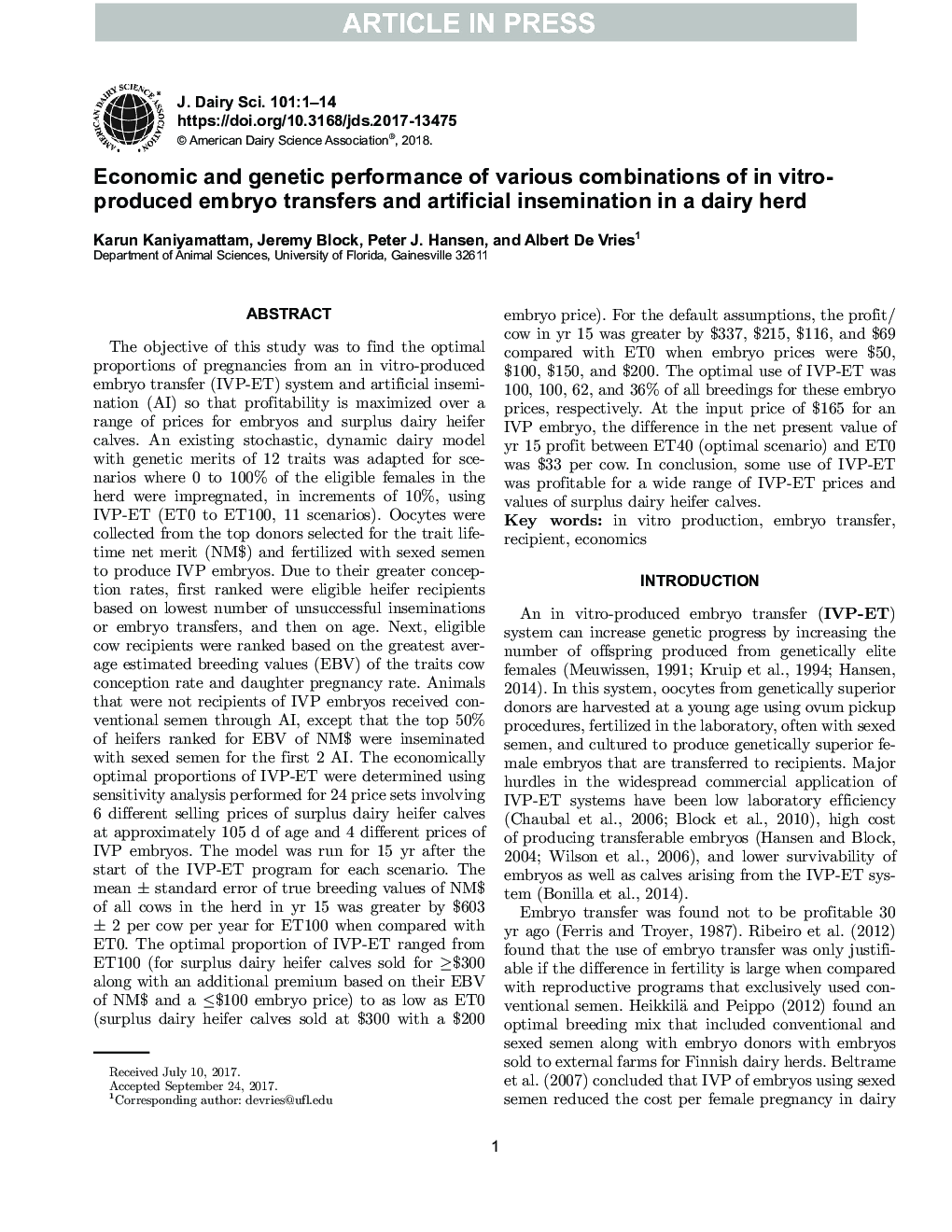| کد مقاله | کد نشریه | سال انتشار | مقاله انگلیسی | نسخه تمام متن |
|---|---|---|---|---|
| 8501698 | 1553843 | 2018 | 14 صفحه PDF | دانلود رایگان |
عنوان انگلیسی مقاله ISI
Economic and genetic performance of various combinations of in vitro-produced embryo transfers and artificial insemination in a dairy herd
ترجمه فارسی عنوان
عملکرد اقتصادی و ژنتیکی ترکیب های مختلف انتقال جنین در شرایط آزمایشگاهی و تلقیح مصنوعی در یک گله شیری
دانلود مقاله + سفارش ترجمه
دانلود مقاله ISI انگلیسی
رایگان برای ایرانیان
کلمات کلیدی
موضوعات مرتبط
علوم زیستی و بیوفناوری
علوم کشاورزی و بیولوژیک
علوم دامی و جانورشناسی
چکیده انگلیسی
The objective of this study was to find the optimal proportions of pregnancies from an in vitro-produced embryo transfer (IVP-ET) system and artificial insemination (AI) so that profitability is maximized over a range of prices for embryos and surplus dairy heifer calves. An existing stochastic, dynamic dairy model with genetic merits of 12 traits was adapted for scenarios where 0 to 100% of the eligible females in the herd were impregnated, in increments of 10%, using IVP-ET (ET0 to ET100, 11 scenarios). Oocytes were collected from the top donors selected for the trait lifetime net merit (NM$) and fertilized with sexed semen to produce IVP embryos. Due to their greater conception rates, first ranked were eligible heifer recipients based on lowest number of unsuccessful inseminations or embryo transfers, and then on age. Next, eligible cow recipients were ranked based on the greatest average estimated breeding values (EBV) of the traits cow conception rate and daughter pregnancy rate. Animals that were not recipients of IVP embryos received conventional semen through AI, except that the top 50% of heifers ranked for EBV of NM$ were inseminated with sexed semen for the first 2 AI. The economically optimal proportions of IVP-ET were determined using sensitivity analysis performed for 24 price sets involving 6 different selling prices of surplus dairy heifer calves at approximately 105 d of age and 4 different prices of IVP embryos. The model was run for 15 yr after the start of the IVP-ET program for each scenario. The mean ± standard error of true breeding values of NM$ of all cows in the herd in yr 15 was greater by $603 ± 2 per cow per year for ET100 when compared with ET0. The optimal proportion of IVP-ET ranged from ET100 (for surplus dairy heifer calves sold for â¥$300 along with an additional premium based on their EBV of NM$ and a â¤$100 embryo price) to as low as ET0 (surplus dairy heifer calves sold at $300 with a $200 embryo price). For the default assumptions, the profit/cow in yr 15 was greater by $337, $215, $116, and $69 compared with ET0 when embryo prices were $50, $100, $150, and $200. The optimal use of IVP-ET was 100, 100, 62, and 36% of all breedings for these embryo prices, respectively. At the input price of $165 for an IVP embryo, the difference in the net present value of yr 15 profit between ET40 (optimal scenario) and ET0 was $33 per cow. In conclusion, some use of IVP-ET was profitable for a wide range of IVP-ET prices and values of surplus dairy heifer calves.
ناشر
Database: Elsevier - ScienceDirect (ساینس دایرکت)
Journal: Journal of Dairy Science - Volume 101, Issue 2, February 2018, Pages 1540-1553
Journal: Journal of Dairy Science - Volume 101, Issue 2, February 2018, Pages 1540-1553
نویسندگان
Karun Kaniyamattam, Jeremy Block, Peter J. Hansen, Albert De Vries,
